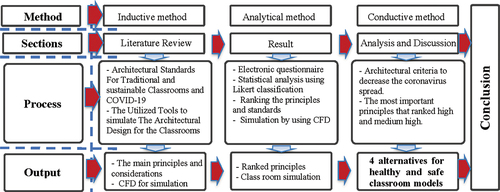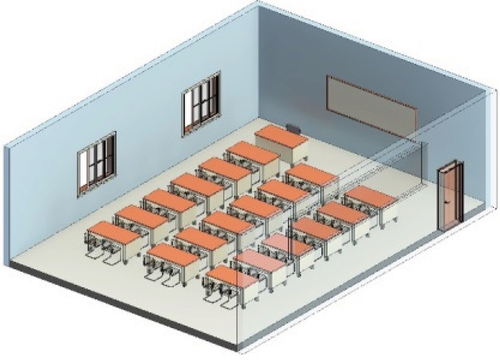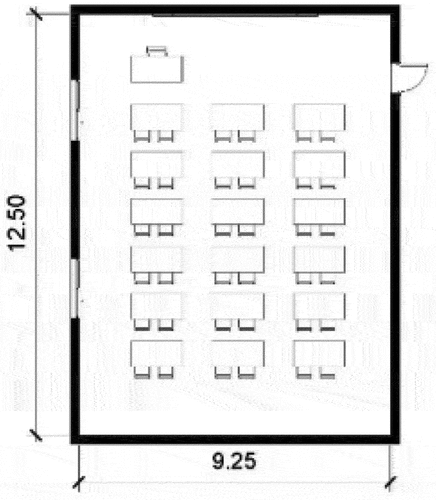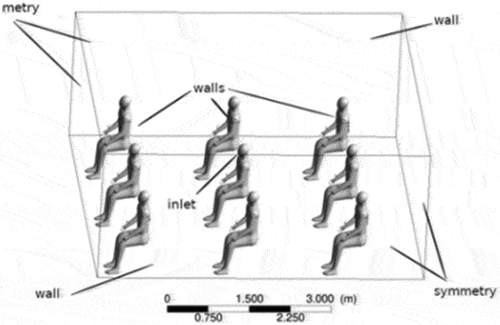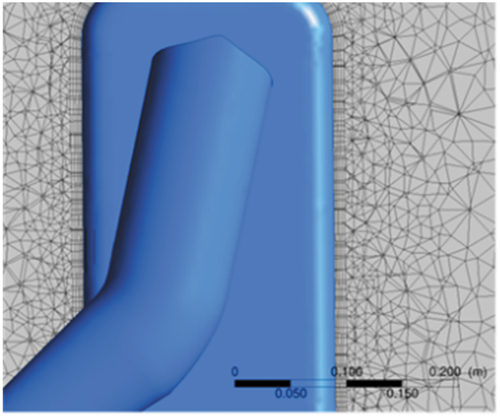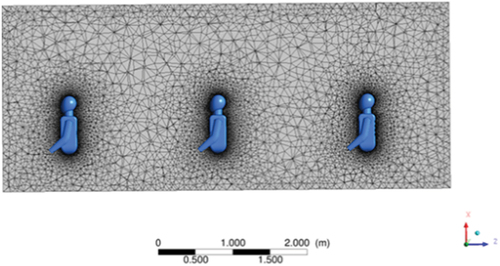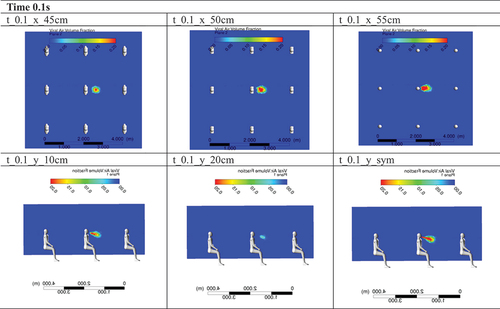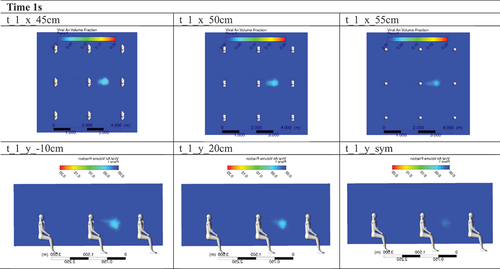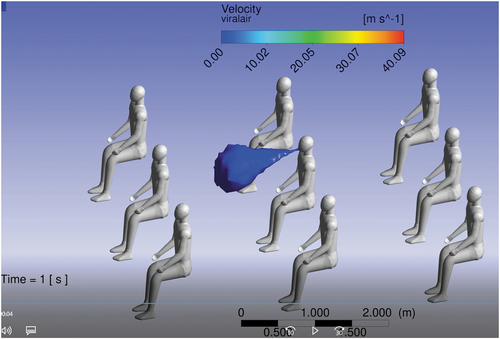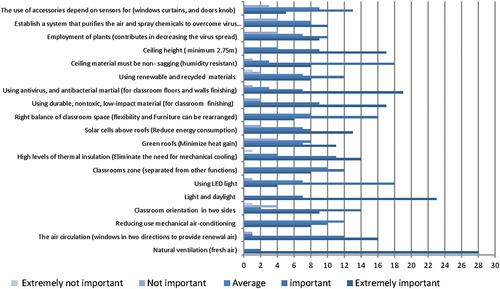ABSTRACT
In March 2020, the World Health Organization (WHO) officially announced the COVID-19 outbreak as a global pandemic. With this announcement, the world is facing a major challenge. This research commenced as an initiative to conceptualize internal architectural space design to cope with epidemics, to ensure an architectural anti-virus environment. In fact, architectural spaces with high occupancy loads are considered a fertile environment for the spread of this virus. This study discusses classrooms as one of those patterns with high densities for a significant reason; previous studies have revealed that pupils between the ages of 5 to 18 years may be carriers of the infection, but without symptoms; therefore, this category is considered a major source of transmitting the infection to their families and society. Accordingly, this research will address the most important standards, and design norms for these spaces using an electronic questionnaire and computational fluid dynamics (CFD) model, to achieve two objectives: first, a healthy classroom to reduce the COVID-19 infection among pupils to promote both wellbeing and performance of users, and second, a sustainable classroom from architecture, HVAC, and a medical point of view. In addition, four alternative classroom designs were proposed based on the interpretive results from the questionnaire and simulation.
1. Introduction
Regarding the 2015 UN summit under title (Transforming our world: Sustainable Development Plan 2030) recommendations, which adapted 17 goals (United Nations Citation2015), the new agenda concentrates on issues related to health and education within specific goals as: (Goal 3) “Ensure healthy lives and promote well-being at all ages” Goal 4: “Ensure inclusive and equitable quality education, and promote lifelong learning opportunities for all” Therefore, acquiring a healthy and successful educational process becomes mandatory to accomplish sustainability via a multidisciplinary and holistic approach, whereas pupils spent approximately 80% of their time schedule in classrooms, which means the classroom design is considered the main pivot to achieve sustainability goals 3 and 4.
Indeed, as a result of the COVID-19 pandemic, a new era in architectural design for classrooms should be initiated. Specifically, the architectural environment post- COVID-19, will not be as pre-COVID. This is attributed to the fact that the world is currently facing a global crisis regarding the spread of epidemics. Accordingly, the World Health Organization (WHO) specified a social distancing of 2 m (UNICEF for every child, UN Educational and WHO. Citation2020). Explicitly, the internal architectural spaces design is responsible for contributing to the reduction of the epidemic spread. In addition, classroom spaces are considered the most important space in a school building, where they represent 60 %–70% (Winnipeg Citation2018) of the building spaces.
In the same context, sustainable architecture is a holistic approach; it is too difficult to determine an absolute definition for it, where it has been examined from various points of view, according to study priorities in every period. Recently, after the COVID-19 pandemic, it has become crucial to argue the concept of “eco-medical” (Guy and Farmer Citation2001) as an additional goal to achieve sustainable building; therefore, this goal should be implemented in all building processes.
In this respect, several authors discuss how Coronavirus will reshape Architecture. Kyle (Citation2020) further stated an example of how Hugo Aalto (a Finnish modernist architect) designed a sanatorium for the treatment of tuberculosis. The same author designed a rigid geometric building with long walls, wide windows and light-colored rooms with a wide roof terrace. Kyle further added that the architecture itself was part of a cure. Moreover, he documented that architects worldwide cooperated with doctors to build sanatoriums. Moreover, Kyle stated that modernist architecture emerged in the twenties by Le Corbusier in France. In addition, he advocated that the globe arrived at a new juncture of disease and architecture, where the panic of contamination controls the kind of internal architectural spaces. Kyle proposed a vision for future antivirus internal spaces, as illustrated in .
Figure 1. Vision to architectural internal spaces as described by Kyle (Citation2020)
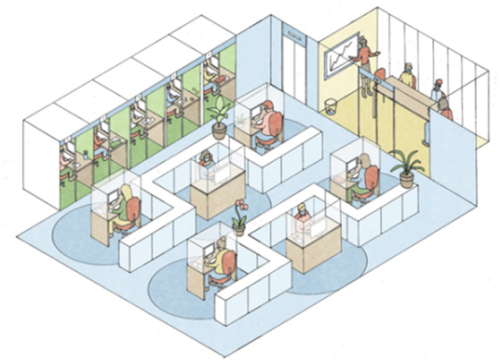
In addition, Naglaa A. Megahed (Citation2020) imagined an antivirus-built environment based on learned lessons. She documented the importance of designing a healthy and sustainable environment. Naglaa advocated that the positive impact of the COVID-19 pandemic was that it offered architects an opportunity to build an environment reflecting past events, and also learn what could be improved for future responses. Naglaa offered a vision to the future antivirus environment; she suggested that multidisciplinary studies should be performed to provide responses to several unanswered questions, and to add security layers to astound future virus attacks.
From another perspective, there are several medical facts about COVID-19 published in research journals, that may have a significant impact on the formation of architectural spaces. For instance:
For virus replication, viruses must establish parasitic relationships with different eukaryotic and prokaryotic host cells (Patrick Citation2006).
COVID-19 is highly contagious and spreads mainly through respiratory droplets from COVID-19 patients when coughing and sneezing. Control of SARS‐CoV‐2 infections mandates the implementation of precautions adopted with various respiratory viruses. The most evident measure is circumventing contact with COVID-19 patients. In addition, wearing face masks and washing hands with soap and water, using alcohol-based antiseptics can fundamentally minimize the probability of contracting the infection. Moreover, direct contact of the nose, eyes, and mouth with unclean hands should be avoided. Regular disinfection of premises and surfaces can fundamentally limit the spread of COVID-19 (Ashour et al. Citation2020).
The World Health Organization (WHO) and several governments have approved at least an inter-personal space of 1.5–2 m (approximately 6 feet), to minimize the risk of contracting COVID-19 infection via respiratory droplets that are commonly propagated around the nose and mouth (Setti et al. Citation2020).
Accordingly, this research will discuss the most important standards and design norms for these spaces to achieve two objectives: first, a healthy classroom to reduce the COVID-19 infection between pupils, by adopting an initiative to conceptualize internal architectural classroom space design to cope with epidemics, and to ensure an architectural anti-virus environment; second, a sustainable classroom; therefore, a sustainable school from an architectural and medical point of view.
2. Literature review
2.1. The educational classrooms between sustainability and COVID-19
Learning occurs when pupils feel secure and safe (Lodal Citation2008) , have all their senses engaged, feel linked to the world, and are challenged to learn and grow intelligently. Consequently, the creation of a vibrant learning classroom is crucial for achieving the learning objectives. However, after the COVID-19 pandemic, classroom space design is increasingly being utilized by the health society to treat specific health concerns, and classroom designs can, and should play a positive role in treating the rising level of virus infections among pupils. The infection among pupils in classrooms can be transmitted via multiple routes: person-to-person contact, air, and touching contaminated surfaces (furniture) (ECDC Citation2020).
2.2. Architectural standards for traditional classrooms
Educational Facility Planners International (CEFPI) define traditional classrooms as classrooms having a narrow table and movable chair configuration, or both traditional tablet arm chair configurations. Room capacities typically range from (30 to 75 stations), and each station size between (1.67–2.78 m2). Classroom architectural design considerations are not to be considered as absolute standards, where, in the last decade, it continues to evolve and has become a more active environment, and flexibility in both layout and technology is essential to achieve a good interaction between educators and pupils. Furthermore, there are recommended standards that may directly affect the classroom design process, as illustrated in .
Table 1. Architectural considerations for traditional classrooms.
2.2.1. Sustainable classrooms and COVID-19
Several studies have discussed sustainable schools and classrooms. While conventional schools are designed according to building codes, sustainable school design challenges designers to go beyond the codes to enhance building performance and minimize environmental impacts. Understandably, this approach differs from the conventional design/build process, where it scrutinizes the integration of all building components and determines how they best work together to save energy and reduce environmental impacts, both during construction and the operation of the building, as well as places of learning and teaching (classrooms), which could help pupils understand the impact they have on the environment, by providing pupils with opportunities to connect with themselves, their community, and their local environment and nature (Emilia, Forth, and Corbett. Citation2016).
Subsequently, to create classrooms that achieve sustainability and a healthy environment, as well as to reduce COVID-19 infection, the authors have striven to summarize the key principles, method of application, and its impact in achieving sustainable classrooms and the “eco-medical” concept from the previous literature reviews as indicated in .
Table 2. Architectural principles for “eco-medical” classrooms.
2.2.2. The utilized tools to simulate the architectural design for the classrooms
(Tang et al. Citation2013), performed real-time shadowgraph imaging, to capture high-speed images of six volunteers sneezing or breathing. The sneeze was stimulated by a pepper smell. They designated that the sneeze plumes travelled 0.6 m, where the sneeze velocity was 4.5 m/s. However, for nasal breathing, the plumes travelled 0.6 m, with a velocity of 1.4 m/s. In addition, Sivaji and Lai (Citation2020) analyzed the spatial droplet concentration of human sneezing and its impact on an adjacent person experimentally and numerically. The experiments were performed in a 2.3 × 2.3 × 2.3 m3 room with a source, and susceptible at a fixed distance, where different locations were tested. This was achieved for two ventilation schemes: well mixed ventilation (“WMV” Well Mixed Ventilation and “DV” Displacement Ventilation (DV). However, a drift-flux model (i.e. “CFD” Computational Fluid Dynamics model) performed the sneezing numerical simulations. The experimental and numerical results were in good agreement. Moreover, Busco et al. (Citation2020) implemented “CFD” approach, to predict pathogens aerosol and droplets spread. They considered the biomechanics of a sneeze (i.e., muscle contractions and dynamic pressure during sneezing) and human factors. Moreover, they performed sensitivity analyses based on environmental conditions, where they described the impact in terms of virus spread.
3. Method
The research was divided into three sections, as illustrated in and discussed below.
3.1. The first section
Desk-based research, and by using the inductive method, the research discusses how coronavirus will reshape the architecture, summarizing the main architectural standards and principles for classroom design, and the key principles for achieving a sustainable classroom and the “eco-medical” concept by reviewing the existing literature. These standards and principles were then adopted as a part of the input parameters for the classroom simulation, and as part of the survey questions to benchmark what principles and standards are prioritized for reducing coronavirus infection, by selecting (19) design principles for evaluation in the electronic questionnaire.
3.2. The second section
Based on, “evidence-based design to improve performance” concept (Ihab Citation2016), a base-line survey was conducted (electronic questionnaire) to measure the effectiveness of the classroom design on pupils achievement, to provide best practices, reduce COVID-19 infection, and to design a healthy environment classroom. From a desk-based research, the authors were able to identify multiple grassroots stakeholders involved in making key decisions related to sustainable classroom design and COVID-19 pandemic (UNICEF for every child, UN Educational and WHO. Citation2020), and distributed 30 electronic questionnaires as follows: 16 for architects with a percentage of 53.3%, 7 for doctors specializing in chest diseases and immunology with a percentage of 23.3%, and 7 for HVAC consultants with a percentage of 23.3%. The results of the electronic questionnaire are summarized in Appendix.
Based on the results of the electronic questionnaire, and by using the analytical method, a statistical analysis was calculated; starting from calculating the coefficient of variance (CV) to measure the homogeneity of the sample, and concluding the relative importance index (RII) by using Likert classification (k) as: (N5) = Extremely important- (N4) = important – (N3) = Average- (N2) = Not important – (N1) = Extremely not important; and finally, the study set the importance level and relative ranking for each classroom design principle and standard as follows:
RII = 0 : 0.20 = Importance level (Low = L)
RII = 0.21 : 0.40 = Importance level (Medium low = M-L)
RII = 0.41 : 0.60 = Importance level (Medium = M)
RII = 0.61 : 0.80 = Importance level (Medium high) = M-H)
RII = 0.81 : 1.00 = Importance level (High = H)
Regarding the CV result, the average was 14.252 (between 10–20), which means that the sample was homogeneous and balanced where:
CV< 10 = Excellent sample
CV(between 10–20) = Very good
CV(between 20–30) = Acceptable
CV(between 30–40) = Low
CV> 40 = Unacceptable
3.3. In the third section
A realistic numerical modeling approach was achieved to assess the human sneeze explicitly; therefore, we reshaped public dense spaces (classrooms) based on the most important principles that ranked (high, medium-high) from the results of the questionnaire as well as the CFD parameters, to propose four alternative healthy and safe classroom models using the conductive method. The simulation process was performed under normal environmental conditions for indoor spaces (classroom), with a wind speed of 0–0.2 m/s, a temperature of 23°C,, and humidity of 40% in the case of closed windows, to investigate the extent of air saturation with virus in the worst conditions. The authors have implemented model and classroom discretization including the modeled geometry to create a mesh as follows:
3.3.1. Implemented model
Primarily, available numerical models were investigated, from which the CFD model was chosen for implementation. Theoretically, CFD imposes a momentum-source term, and couples it to Eulerian–Lagrangian – momentum equations. CFD is widely accepted because it provides reliable results in previous applications.
3.3.2. Classroom discretization
The classroom was discretized to simulate the flow in part of it having an infected student sneezing. The discretization process considers that the pre-corona crisis classroom furniture is provided from the existing literature review, as illustrated in . Classroom discretization proceeded by specifying the classroom geometry, identifying the mesh, and simulating the classroom. These steps are elaborated as follows:
Specifying classroom geometry: The classroom geometry was specified. Its dimensions were 9.25 × 12.5 × 3 m, as illustrated in . The dimensions were selected to reduce the effect of boundary conditions on the flow parameters (Srebric et al. Citation2008). In addition, the pupils were 2 m apart, according to the World Health Organization recommendation, (Cirrincione et al. Citation2020; Hishan et al. Citation2020; Salama Citation2020).
Identifying the mesh: The meshing process applies a hybrid meshing technique. ANSYS meshing was implemented, where the domain was divided into smaller cells to compute the flow variables. Cells were hexagonal near pupils, and tetrahedral; otherwise, .
Simulating the Classroom: After designating the classroom geometry and specifying the mesh, the classroom was simulated using CFD. To initiate the CFD computation, several y parameters were specified as follows:
Pupils, roof, and top were set to be no-slip conditions,
Classroom boundary sides were set to be symmetrical-boundary-conditions,
A student mouth, in the middle of the classroom, was set to be an inlet boundary condition with air full of virus (Seepana and Lai. Citation2012),
The inlet velocity was 4 m/s (Tang et al. Citation2013).
It should be noted that a “k-epsilon-turbulence model was utilized to achieve turbulence modeling. However, a dispersion model was implemented to simulate the interaction between air and full-virus air. In addition, for a multi-phase flow (volume of the fraction), “VOF” was tooled.
4. Result
The results of the study were divided into two sections: the first is related to the electronic questionnaire, and the second is related to the classroom model simulation, as illustrated below.
First, from the statistical analysis of the electronic questionnaire, and after the verification of the questionnaire via dispersion and CV coefficients as illustrated in and , 9 principles ranked High, and 10 principles ranked High-Medium. The distribution of the relative ranks is presented in . Accordingly, the analysis results determined the most important principles that ranked from 1 to 5 according to the evaluation of the root stakeholders : natural ventilation and fresh air, light and daylight, using antivirus, and antibacterial martial (for classroom floors and walls finishing), ceiling height (minimum 2.75 m), air circulation (windows in two directions to provide renewal air), and using durable, nontoxic, low-impact material (for classroom finishing). In fact, this result reflects that the classroom design must depend on the fresh air and daylight, and ceiling height has an important role, especially in improving the air circulation in the classroom where these two principles were ranked 4, as well as using antivirus, antibacterial, nontoxic, and low impact materials, which ranked 3and5. Similarly, the principles that are ranked from 6 to 8 as high levels of thermal insulation (eliminating the need for mechanical cooling), ceiling material must be non-sagging (humidity resistant), and solar cells above roofs (reduce energy consumption), which confirms the importance of the environmental design approach to optimize energy consumption, and reduce the use of mechanical air-conditioning. As regards the 10 principles ranked High-Medium, 2 principles ranked (9) as: classrooms zone (separated from other functions), and right balance of classroom space (flexibility and furniture can be rearranged), in fact, that reflects the importance of isolating the classroom zone to reduce the probability of infection; In addition, flexibility in furniture could play a significant role by providing a safe distance between the pupils during practice of various activities in classrooms. In the same context, 2 principles ranked 10 as reducing the use of mechanical air-conditioning and classroom orientation on two sides, which emphasizes the importance of using natural ventilation, and the second principle is effective in classroom air circulation. Subsequently, using LED light and green roofs minimize heat gain, ranked 11, using renewable and recycled materials, employment of plants, and establishing a system that purifies the air, and spray chemicals to overcome the virus spread ranked 12. Finally, the use of accessories depends on sensors for windows curtains and door knobs ranked 13.
Table 3 The statistical analysis of the electronic questionnaire result.
Second, during the analytical investigation and monitoring the performance of the infected student in the classroom during sneezing (i.e., spread of viruses), the air saturation was specified as illustrated in Diagram 1, 2, 3, 4, and . These diagrams provided graphs of sneeze diffusion cone coordinates as
The visual display of horizontal planes in the architectural vacuum at three levels of a sitting student, at 0.45,0.50 and 0.55 m, after sneezing by 0.1, 0.4,0.7 and 1 s,
The visual display of vertical planes in the architectural vacuum at three levels of a sitting student, at 0.20, 0.10, and 0 m away from the symmetry line, after sneezing by 0.1, 0.4,0.7, and 1 s.
From the diagrams, it was evident that the sneeze impact did not exceed 1.7 m, after 0.1, 0.4, 0.7, and 1 s. In addition, the diagrams identified the spread of air particle vibration; hence, the minimum distance between pupils should be 2 m, and the minimum limit of the student occupancy rate 5.7 m2, to reduce the probability of infection.
5. Analysis and discussion
Regarding the electronic questionnaire results, the research’s root stakeholders, whether architects, HVAC consultants, and chest diseases and immunology doctors, agreed on 10 key principles out of 19 principles, to be a priority while designing a sustainable classroom in the COVID-19 epidemic. Improving natural ventilation (fresh air), daylight, cross-ventilation to provide renewal air, separating classrooms zone from other functions, and using antivirus, antibacterial martial, durable, non-toxic, low-impact material for classroom finishing were at the top of those priorities. In this respect, which reflects a clear shift in the concept of achieving sustainability, where root stakeholders have tended to make the provision of a healthy and safe environment their top priority, where reducing energy consumption principles using green roofs, LED light, and using renewable and recycled materials, it came in the second stage of stakeholder priorities, according to the relative rank of the questionnaire results.
In addition, using smart technologies and tools can curb virus spread as follows
The use of copper and its alloys such as bronze or brass is inherently antimicrobial, disrupting key cell functions once the metals are exposed to bacteria or viruses, where the COVID-19 virus is rendered inactive within four hours on copper (Warnes, Little, and Keevil Citation2015), (van Doremalen et al. Citation2020).
Establish systems that purify the air, in fact, these systems technology is based on destroying pathogens that can be transmitted through air, by recirculating air filtration (Lisa et al. Citation2019). Plasma-based technology can play a sufficient role in air filtration, because it utilizes a high-voltage discharge to break down and remove particulate matter, and absorbent materials technology can be utilized to remove gaseous pollutants from indoor air by the use of often activated carbon or hydrophobic zeolites, which collect the contaminants on the surface. Recently, several studies have proven that both of these technologies seem to be highly efficient methods for the spread of viruses (Emily et al. Citation2021).
Ultraviolet light is considered an effective tool against germs and viruses, and ultraviolet (UV) germicidal irradiation (UVGI) is considered one of the tools for air purification, via its capacity to destroy bacteria and viruses by UV radiation from photoreactor lamps, where it functions as a mutagen and damages microbial DNA. In addition, its effectiveness is dependent on the dose (j/m2), UV intensity (w/m2), and exposure time (Lidia and Donald Citation2020).
Use of accessories that depend on sensors for windows curtains and doorknobs.
Masks as a protection tool have an effective role in reducing infection. The WHO recommended wearing N95 masks which is 95% sufficient at filtering airborne particles including very minute ones (Martijn and Edwin Citation2020).However, UNICEF and several recent articles argue the use of protective masks for pupils in schools, by applying criteria regarding the pupil’s age, where pupils under five years are not required to wear a mask, pupils between 6 and 11 years must wear the mask in the high-density areas, and pupils over 12 must wear it all the time in school; these criteria are designed to avoid the negative impact of the masks, like the physical side effects. Face masks impair face recognition and face identification, verbal and non-verbal communication, and block emotional signaling between teachers and pupils (UNICEF, WHO Citation2020).
However, from the classroom model simulation results and analysis, architectural criteria can be identified to decrease the coronavirus spread. These criteria are summarized as follows.
The sneeze impact did not exceed 1.7 m, after a sneeze within 1 s. The actual limits, such as the spread of the air particle vibration extent, were designated. The obtained results contribute to the conceptualization of appropriate architectural solutions.
Accordingly, the criteria that should be followed within the classroom to raise the efficiency of the response to the coronavirus, are to recommend the movement paths (get furniture placement); add more than one entrance to reduce movement paths intersections, reduce the student density and design the classroom area in accordance to the architectural spaces post-COVID to be 9.20 × 12.5 m, but with the number of pupils from 9 to 20 pupils in the class, and the occupancy rate range from 5.7 m to 12.7 m in the cases proposed by the research to reflect social distancing.
Considering movement paths and employing plants should be taken into consideration in the classroom layout, as this affects the student work rate.
Moreover, the rules to be well thought out in the classroom are to determine the distance between pupils (2 m and not less than 1.7,) based on the results, and the addition of built-in glass partitions in the form of interior furnishings.
The norms that should be deliberated within the classroom are to establish a system that purifies air, regulates natural ventilation, enables cross ventilation, spray chemical materials to overcome virus spread, sterilize classrooms, and add basins at the entrance with sensors to avoid opening and closing.
From the questionnaire, classroom model simulation results, and discussion, it is evident that designing a built-in anti-virus environment will protect against coronavirus or other epidemics. Accordingly, four alternatives for classroom models were proposed, as presented in .
Table 4 Proposed classroom models.
In light of the proposed models, the classroom shape with an area of 115 m2 and (12.5*9.25 m), can provide the ability to arrange the furniture in several shapes, thereby minimizing interaction, ensuring interpersonal social distance, and maintaining social isolation. More specifically, each model can be presented as follows.
Model 1: The classroom area is 115 m2, the rate of occupancy 12.7 m2, and the total number of pupils that can be accommodated is 9. This model is considered the optimum to be utilized for infected pupils (a classroom to isolate the infected pupils), where four paths with width 1.5 m and 2 m from the desk center are provided, to reduce the direct intersection, and increase the buffer of protection, and a 2 m distance is provided between the desks in similar rows.
Model 2: the classroom area is 115 m2, the rate of occupancy is 7.6 m2, and the total number of pupils that can be accommodated is 15, two paths with a width of 1.25 m in the longitudinal direction, and two paths with a width of 1.40 m in the transverse direction were provided, the furniture was arranged staggered, and a glass partition with a height of 80 cm was added to minimize the spread of sneezing.
In model 3, the classroom area is 115 m2, the rate of occupancy is 5.7 m2, and the total number of pupils that can be accommodated is 20. Two paths with a width of 1.5 m in the longitudinal direction, and one path with a width of 2 m in the transverse direction are provided, and the employment of plants and glass partitions were added, to contribute to decrease the virus spread and increase the percentage of O2.
Model 4: The classroom area is 115 m2, the rate of occupancy is 5.7 m2, and the total number of pupils that can be accommodated is 20, three paths with widths of 1.25 m in the longitudinal direction, and one path with a width of 2 m in the transverse direction are provided. The furniture was arranged as a work station unit, and a glass partition with a height of 80 cm was added to minimize the spread of sneezing.
In addition, all the results obtained from the questionnaire and simulation were applied, for instance, ensuring cross ventilation to ensure air renewal in all the models. In addition, adding basins at the entrances to the classrooms depending on the sensor, a surveillance camera system to wear the mask, and a sensor to monitor the spacing between pupils could help reduce the spread of the virus.
6. Conclusion
The term sustainability in architecture has been argued concerning different priorities in every period. After the COVID-19 pandemic, the energy consumption for the building became an insignificant issue, providing a safe and healthy building took the first place, especially in the high occupancy spaces, to reduce the infection, therefore, the term “eco-medical,” and its design principles must be applied at least for the next 10 years to fight this pandemic. Similarly, it can be applied to architectural spaces with high occupancy loads. Implementing the design principles (evidence-based design guidelines) concluded from the multidisciplinary questionnaire and simulation for the classroom design process, could enhance long-term healthy and safe spaces for the pupils and society as follows
Natural ventilation and fresh air, light, and daylight, using antivirus and antibacterial martial for classroom floors and walls finishing, ceiling height (minimum 2.75 m), and air circulation (cross-ventilation).
Flexible classroom furniture designs in the four proposals could ensure interpersonal social distance, and maintain social isolation by concentrating on movement paths.; Specifically, the internal architectural space design is responsible for contributing to the reduction of epidemic spread.
The classroom shape with an area of 115 m2 and 12.5 × 9.25 m could promote space sustainability, where the furniture design could be changed to be adaptable for all educational functions during pandemic events; therefore, the architecture itself is part of the cure.
In the relevant context, governments should be interested in applying research recommendations. Thus, parents will select designated classes that prevent virus spread to protect their children, and multidisciplinary studies should be performed to provide responses to several unanswered questions, to add security layers, and to be prepared to face future virus attacks.
Finally, “after the COVID-19 pandemic, building spaces are no longer concrete and bricks, it has become like lungs which need to breathe fresh and clean air to ensure healthy living., Schools will require a much larger area, and new standards must be considered in the design process, especially classrooms distribution regarding pupils age”
Disclosure statement
No potential conflict of interest was reported by the author(s).
References
- Ashour, H. M., W. F. Elkhatib, M. M. Rahman, and H. A. Elshabrawy. 2020. “Insights into the Recent 2019 Novel Coronavirus (Sars-cov-2) in Light of past Human Coronavirus Outbreaks.” Journal of Pathogens (March): 136–150. doi:10.3390/pathogens9030186.
- ASU Arizona State University. 2019. “Campus Technology Space Standards.” University Technology Office. Accessed 20 March 2021. https://www.asu.edu/fm/documents/project_guidelines/Classroom-Design-Guidelines.pdf
- Britch Columbia; Ministry Of Education. 2010. “Sustainable Schools: Best Practices Guide.” Accessed March 2021. https://www.esd.ca/Programs/Documents/Guide%20for%20Sustain%20SchoolsMB.pdf
- Busco, G., S. R. Yang, J. Seo, and Y. A. Hassan. 2020. “Sneezing and Asymptomatic Virus Transmission.” Journal of Physics of Fluids 32 (7): 073309. doi:10.1063/5.0019090.
- Cirrincione, L., F. Plescia, C. Ledda, V. Rapisarda, D. Martorana, R. E. Moldovan, and E. Cannizzaro. 2020. “COVID-19 Pandemic: Prevention and Protection Measures to Be Adopted at the Workplace.” Journal of Sustainability 12 (9): 3603. doi:10.3390/su12093603.
- ECDC. 2020. “COVID-19 in Children and the Role of School Settings in COVID-19 Transmission.” Accessed 23 March 2021. https://www.ecdc.europa.eu/en/publications-data/children-and-school-settings-covid-19-transmission
- Emilia, P., A. Forth, and C. Corbett. 2016. “Better Spaces for Learning: Royal Institute of British Architects (RIBA).” Accessed 18 April 2021. https://www.architecture.com/-/media/gathercontent/better-spaces-for-learning/additional-documents/ribabetterspacesforlearningpdf.pdf
- Emily, C., G. Valentina, S. Clive, and D. Sani. 2021. “Portable Air Purification: Review of Impacts on Indoor Air Quality and Health.” Journal of Science of Total Environment. doi:10.1016/j.scitotenv.2020.142585.
- Guy, S., and G. Farmer. 2001. “Reinterpreting Sustainable Architecture: The Place of Technology.” Journal of Architectural Education 54 (3): 140–148. doi:10.1162/10464880152632451.
- Hishan, S., S. Ramakrishnan, M. Qureshi, N. Khan, and N. Al-Kumaim. 2020. “Pandemic Thoughts Civil Infrastructure and Sustainable Development: Five Insights from COVID‐19 across Travel Lenses.” Journal of Talent Development and Excellence: 1690–1696. https://iratde.com/index.php/jtde/article/view/694
- Ihab, E. 2016. “Green Classroom Toolbox: Adapting Schools and Students for Climate Change through Sustainable Architecture.” Conference, Sustainable Built Environment, Egypt. https://www.researchgate.net/publication/326753735_Green_Classroom_Toolbox_Adapting_Schools_and_Students_for_Climate_Change_through_Sustainable_Architecture
- Jane, W. 2008. “Leading Sustainable School Building Projects.” National College for school leadership. Forum of the Future. Accessed on May 2021. http://shine-network.org.uk/wp-content/uploads/2016/01/NCSL-Leading-sustainable-school-building-projects-2008.pdf
- Kyle, C. 2020. “How the Coronavirus Will Reshape Architecture?” The New Yorker. https://www.newyorker.com/culture/dept-of-design/how-the-coronavirus-will-reshape-architecture
- Lidia, M., and K. M. Donald. 2020. “It Is Time to Address Airborne Transmission of COVID-19.” Journal of Clinical Infectious Diseases. doi:10.1093/cid/ciaa939.
- Lisa, E., R. Tobias, H. Matthias, S. Simon, T. Uwe, and S. Stephanie. 2019. “Impact of UVC-sustained Recirculating Air Filtration on Airborne Bacteria and Dust in a Pig Facility.” Journal of Plos One. doi:10.1371/journal.pone.0225047.
- Lodal., E. V. 2008. “Design for Learning Forum: School Design and Student Learning in the 21st Century.” A Report of Findings. American Architectural Foundation: Washington, D.C., 27. https://docplayer.net/7094199-School-design-and-student-learning-in-the-21-st-century.html
- Martijn, V. G., and B. Edwin. 2020. Others. “Face Masks: Benefits and Risks during the COVID‑19 Crisis.” European Journal of Medical Research. doi:10.1186/s40001-020-00430-5.
- Megahed Ehab, N. A., and M. Ghoneim. 2020. Antivirus-Built Environment: Lessons Learned from Covid-19 Pandemic. Journal of Sustainable Cities and Society. doi:10.1016/j.scs.2020.102350
- Patrick, F. 2006. “The Origin of Viruses and Their Possible Roles in Major Evolutionary Transitions.” (April): 5–16. doi:10.1016/j.virusres.2006.01.010.
- Salama, A. 2020. “Coronavirus Questions that Will Not Go Away: Interrogating Urban and Socio-Spatial Implications of COVID-19 Measures.” Emerald Open Research: 2–14. doi:10.35241/emeraldopenres.13561.1.
- Seepana, S., and A. C. K. Lai. 2012. “Experimental and Numerical Investigation of Exposure of Sneezing.” Journal of Aerosol Science and Technology 46 (5): 485–493. doi:10.1080/02786826.2011.640365.
- Setti, L., F. Passarini, G. De Gennaro, P. B. Maria G., P. Massimo Borelli, J. Palmisani, A. Di Gilio, P. Piscitelli, and A. Miani. 2020. “Airborne Transmission Route of COVID-19: Why 2 Meters/6 Feet of Inter-Personal Distance Could Not Be Enough.” International Journal of Environmental Research and Public Health (April): 1–6. doi:10.3390/ijerph17082932.
- Sivaji, S., and A. C. K. Lai. 2020. “Experimental and Numerical Investigation of Exposure of Sneezing.” Journal of Aerosol Science and Technology 485–493. doi:10.1080/02786826.2011.640365.
- Srebric, J., V. Vukovic, G. He, and X. Yang. 2008. “CFD Boundary Conditions for Contaminant Dispersion, Heat Transfer and Airflow Simulations around Human Occupants in Indoor Environments.” Journal of Building and Environment 43 (3): 294–303. doi:10.1016/j.buildenv.2006.03.023.
- Tang, J. W., A. D. Nicolle, C. A. Klettner, J. Pantelic, L. Wang, et al. 2013. “Airflow Dynamics of Human Jets.” Journal of Plos One. doi:10.1371/journal.pone.0059970.
- UCONN University of Connecticut. 2016. “Classroom Design Guidelines: Planning Architectural and Engineering Services & Classroom Management Committee.” Accessed 10 February 2021. https://paes.uconn.edu/wp-content/uploads/sites/1525/2016/04/Appendix-VI-Classroom_Design_Guide-March-2016.pdf
- UNICEF for every child, UN Educational and WHO. 2020. “Considerations for School-related Public Health Measures in the Context of COVID-19.” Accessed 26 April 2021. https://apps.who.int/iris/rest/bitstreams/1303058/retrieve
- UNICEF, WHO. 2020. “Advice on the Use of Masks for Children in the Community in the Context of COVID-19,” August. Accessed 26 June 2021. https://apps.who.int/iris/rest/bitstreams/1296520/retrieve
- United Nations. 2015. “Transforming Our World: The 2030 Agenda for Sustainable Development.” Accessed 20 March 2021. https://www.un.org/ga/search/view_doc.asp?symbol=A/RES/70/1&Lang=E
- Van Doremalen, N., T. Bushmaker, D. H. Morris, M. G. Holbrook, A. Gamble, B. N. Williamson, A. Tamin, et al. 2020. “Aerosol and Surface Stability of SARS-CoV-2 as Compared with SARS-CoV-1.” New England Journal of Medicine 382 (16): 1564–1567. doi:10.1056/NEJMc2004973.
- Warnes, S. L., Z. R. Little, and C. W. Keevil. 2015. “Human Coronavirus 229E Remains Infectious on Common Touch Surface Materials.” Journal of mBio 6 (6). doi:10.1128/mBio.01697-15.
- Winnipeg, M. 2018. “The Public Schools Finance Board: School Building, Space Standards.” Accessed 26 April 2021. https://sagecreekpac.com/wp-content/uploads/2019/03/School-Building-Space-Standards.pdf
Appendix (1)
: Method (Figure 3 & Table 3)
Table A1. Results of the electronic questionnaire.

